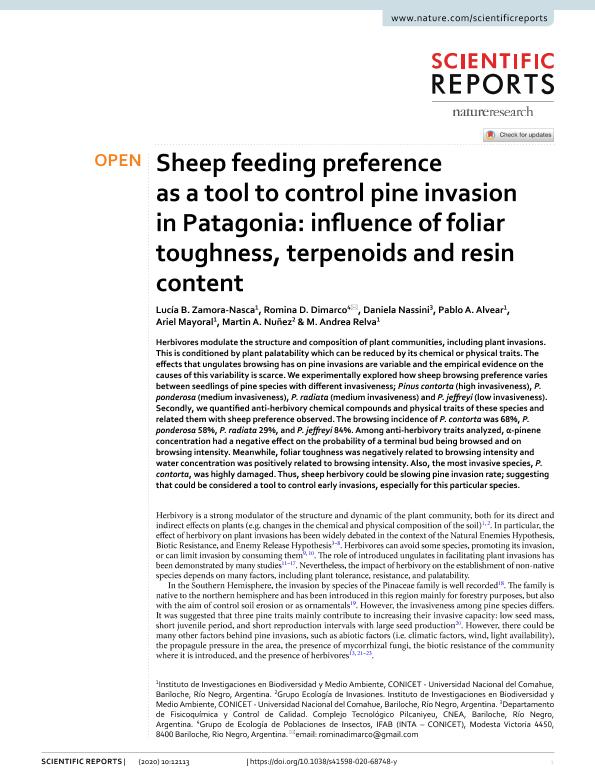Mostrar el registro sencillo del ítem
dc.contributor.author
Zamora Nasca, Lucía Belén

dc.contributor.author
Dimarco, Romina Daniela

dc.contributor.author
Nassini, Daniela

dc.contributor.author
Alvear, Pablo Andres

dc.contributor.author
Mayoral, Ariel Alejandro

dc.contributor.author
Nuñez, Martin Andres

dc.contributor.author
Relva, Maria Andrea

dc.date.available
2023-01-06T09:01:50Z
dc.date.issued
2020-07
dc.identifier.citation
Zamora Nasca, Lucía Belén; Dimarco, Romina Daniela; Nassini, Daniela; Alvear, Pablo Andres; Mayoral, Ariel Alejandro; et al.; Sheep feeding preference as a tool to control pine invasion in Patagonia: influence of foliar toughness, terpenoids and resin content; Nature; Scientific Reports; 10; 1; 7-2020; 1-12
dc.identifier.issn
2045-2322
dc.identifier.uri
http://hdl.handle.net/11336/183655
dc.description.abstract
Herbivores modulate the structure and composition of plant communities, including plant invasions. This is conditioned by plant palatability which can be reduced by its chemical or physical traits. The effects that ungulates browsing has on pine invasions are variable and the empirical evidence on the causes of this variability is scarce. We experimentally explored how sheep browsing preference varies between seedlings of pine species with different invasiveness; Pinus contorta (high invasiveness), P. ponderosa (medium invasiveness), P. radiata (medium invasiveness) and P. jeffreyi (low invasiveness). Secondly, we quantified anti-herbivory chemical compounds and physical traits of these species and related them with sheep preference observed. The browsing incidence of P. contorta was 68%, P. ponderosa 58%, P. radiata 29%, and P. jeffreyi 84%. Among anti-herbivory traits analyzed, α-pinene concentration had a negative effect on the probability of a terminal bud being browsed and on browsing intensity. Meanwhile, foliar toughness was negatively related to browsing intensity and water concentration was positively related to browsing intensity. Also, the most invasive species, P. contorta, was highly damaged. Thus, sheep herbivory could be slowing pine invasion rate; suggesting that could be considered a tool to control early invasions, especially for this particular species.
dc.format
application/pdf
dc.language.iso
eng
dc.publisher
Nature

dc.rights
info:eu-repo/semantics/openAccess
dc.rights.uri
https://creativecommons.org/licenses/by-nc-sa/2.5/ar/
dc.subject
hervivores
dc.subject
invasions
dc.subject
preferences
dc.subject
pinus
dc.subject.classification
Ecología

dc.subject.classification
Ciencias Biológicas

dc.subject.classification
CIENCIAS NATURALES Y EXACTAS

dc.title
Sheep feeding preference as a tool to control pine invasion in Patagonia: influence of foliar toughness, terpenoids and resin content
dc.type
info:eu-repo/semantics/article
dc.type
info:ar-repo/semantics/artículo
dc.type
info:eu-repo/semantics/publishedVersion
dc.date.updated
2021-09-06T20:35:46Z
dc.journal.volume
10
dc.journal.number
1
dc.journal.pagination
1-12
dc.journal.pais
Estados Unidos

dc.description.fil
Fil: Zamora Nasca, Lucía Belén. Consejo Nacional de Investigaciones Científicas y Técnicas. Centro Científico Tecnológico Conicet - Patagonia Norte. Instituto de Investigaciones en Biodiversidad y Medioambiente. Universidad Nacional del Comahue. Centro Regional Universidad Bariloche. Instituto de Investigaciones en Biodiversidad y Medioambiente; Argentina
dc.description.fil
Fil: Dimarco, Romina Daniela. Instituto Nacional de Tecnología Agropecuaria. Centro Regional Patagonia Norte. Estación Experimental Agropecuaria San Carlos de Bariloche. Instituto de Investigaciones Forestales y Agropecuarias Bariloche. - Consejo Nacional de Investigaciones Científicas y Técnicas. Centro Científico Tecnológico Conicet - Patagonia Norte. Instituto de Investigaciones Forestales y Agropecuarias Bariloche; Argentina
dc.description.fil
Fil: Nassini, Daniela. Comisión Nacional de Energía Atómica. Gerencia Complejo Tecnológico Pilcaniyeu; Argentina. Consejo Nacional de Investigaciones Científicas y Técnicas; Argentina
dc.description.fil
Fil: Alvear, Pablo Andres. Consejo Nacional de Investigaciones Científicas y Técnicas. Centro Científico Tecnológico Conicet - Patagonia Norte. Instituto de Investigaciones en Biodiversidad y Medioambiente. Universidad Nacional del Comahue. Centro Regional Universidad Bariloche. Instituto de Investigaciones en Biodiversidad y Medioambiente; Argentina
dc.description.fil
Fil: Mayoral, Ariel Alejandro. Consejo Nacional de Investigaciones Científicas y Técnicas. Centro Científico Tecnológico Conicet - Patagonia Norte. Instituto de Investigaciones en Biodiversidad y Medioambiente. Universidad Nacional del Comahue. Centro Regional Universidad Bariloche. Instituto de Investigaciones en Biodiversidad y Medioambiente; Argentina
dc.description.fil
Fil: Nuñez, Martin Andres. Consejo Nacional de Investigaciones Científicas y Técnicas. Centro Científico Tecnológico Conicet - Patagonia Norte. Instituto de Investigaciones en Biodiversidad y Medioambiente. Universidad Nacional del Comahue. Centro Regional Universidad Bariloche. Instituto de Investigaciones en Biodiversidad y Medioambiente; Argentina
dc.description.fil
Fil: Relva, Maria Andrea. Consejo Nacional de Investigaciones Científicas y Técnicas. Centro Científico Tecnológico Conicet - Patagonia Norte. Instituto de Investigaciones en Biodiversidad y Medioambiente. Universidad Nacional del Comahue. Centro Regional Universidad Bariloche. Instituto de Investigaciones en Biodiversidad y Medioambiente; Argentina
dc.journal.title
Scientific Reports
dc.relation.alternativeid
info:eu-repo/semantics/altIdentifier/url/http://www.nature.com/articles/s41598-020-68748-y
dc.relation.alternativeid
info:eu-repo/semantics/altIdentifier/doi/http://dx.doi.org/10.1038/s41598-020-68748-y
Archivos asociados
